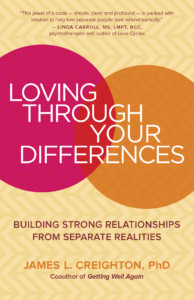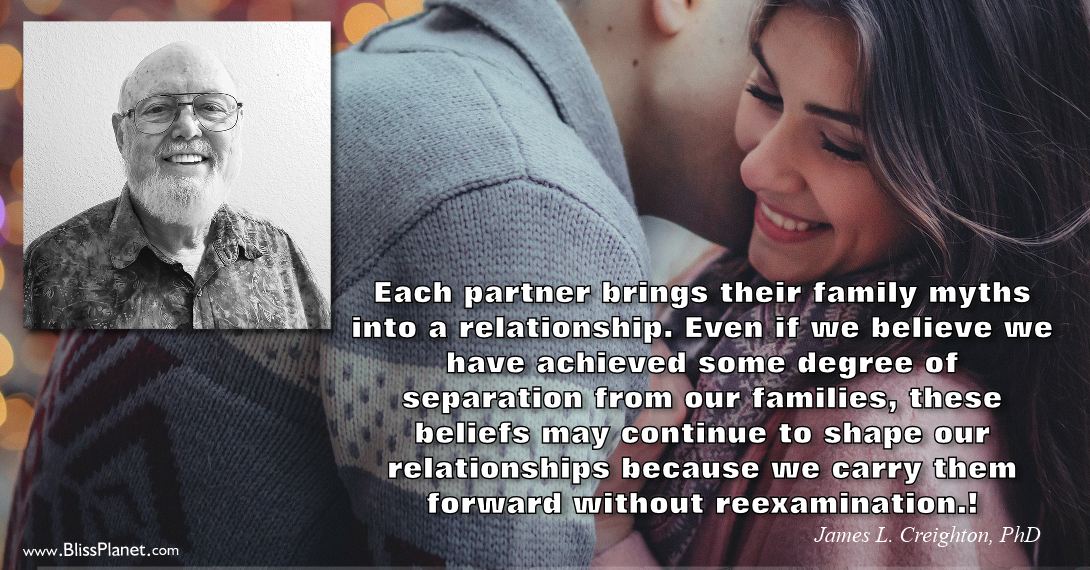An excerpt from Loving through Your Differences by James L. Creighton, PhD
Couples fight. Sometimes a little, sometimes a lot. Sometimes these fights provide comic relief. At other times they threaten the very survival of the relationship.
Psychologist and relationship consultant James Creighton wrote his new book Loving through Your Differences: Building Strong Relationships from Separate Realities to help reduce conflict between couples, especially those that are based on different perceptions or experiences of reality. The book’s primary aim is to empower couples with the knowledge and practical skills they need to choose to live happily and productively together, finding excitement and fulfillment, rather than disappointment and frustration, in their differences. We hope you’ll enjoy this short excerpt.
In our early years we develop our perceptions of reality through our families. Every family shares some basic assumptions about the world. In fact, it is the willingness to accept these assumptions that helps the individual belong to or have “membership” in the family. Often these shared assumptions are not verbalized, or the family may not have openly examined them. Because they are typically not conscious, they are sometimes referred to by people in the field of psychology as the “family trance” or as “family myths.” These myths may encompass rules about closeness or separateness and about what is just or fair, or right or wrong. They may prescribe rules for marital power sharing and for communicating love or worth.
These myths often define our sense of the ideal partner or spouse, the ideal marriage, the ideal family, the ideal child. Each of us carries these expectations from the family in which we grew up. We learn our future family roles while we are children — unless we make the family myth conscious and choose whether or not to adopt it.
Some family myths don’t work well. For example, many families in which one or both parents abuse alcohol or are mentally ill create myths that permit the family to deny this reality. This can often lead to the children abusing alcohol or being attracted to a partner who does so or is mentally ill.
Each partner brings their family myths into a relationship. Even if we believe we have achieved some degree of separation from our families, these beliefs may continue to shape our relationships because we carry them forward without reexamination.
Here’s an example: Judy’s family proudly identifies as working class. This involves much more than the historical fact that they have worked in the steel mills for three generations. The family actively discourages behavior that is inconsistent with this working-class identity. Only certain cars are considered acceptable. No one would be caught dead with a glass of wine when there’s beer available. There’s pressure for family members not to get “above themselves” by getting too much education, buying fancy homes, or “acting like something they’re not.” For Judy’s family, success means being respected and liked by other working-class people.
Judy stretched the limits of the family myth when she went to the state university and earned a bachelor’s degree. While there, she met and fell in love with Dave, whose father is a senior marketing manager for a Fortune 500 corporation. Dave’s father is the second generation of an immigrant family and has made it to his present position by dint of hard work. He doesn’t have a college degree: in fact, he had to drop out of college to support his parents when the company his father worked for went out of business. The family is proud of Dave, who is the first person in their family to get a college degree.
At Dave and Judy’s wedding, there was obvious tension between the families. Many of Dave’s parents’ suggestions for the wedding were interpreted by Judy’s family as signs that Dave’s family didn’t think them good enough. To avoid this tension, Dave and Judy accepted jobs in a city some distance from both families. They like to think they have escaped from their families, but both feel isolated without the strong family support they once enjoyed.
With both Judy and Dave working, they can afford two new cars and even a new house. But each time they make a decision to make such a purchase, painful conflict erupts between them. What Dave sees as a reward for getting ahead, Judy sees as pretension. She even experiences a vague sense of disloyalty to her family. When Judy and Dave try to talk about these issues, their discussions often turn into bitter attacks of each other’s families, with many accusations and counteraccusations about caring more about approval from their families than about the other person.
Family myths create a sense of belonging. Adherence to the myths is a form of bonding. When the myths are challenged — when we think, feel, or act differently than the myth dictates — we may feel that we are traitors or that we are rejecting our families, and we may in turn feel isolated from or rejected by our families. Even when no family members are around to enforce the family beliefs, our inner voices effectively police our efforts to break away.
Judy’s family defines itself by its commitment to its working-class origins. Now that Dave and Judy are family, she sees his upwardly mobile behavior as an attack on her family and feels guilty if she participates in it.
For Dave, Judy’s insistence on maintaining working-class ways is incomprehensible. Dave’s immigrant family has struggled for three generations to escape poverty and everything associated with it. Dave feels that his wife should support him in acquiring the visible proof that his family has finally made it. When she does not provide this support, he interprets her reaction as “wallowing in irrational guilt.” Both Dave and Judy feel that the myths that define their families of origin are under attack, but neither is conscious of how much of their identity is tied up in these family myths.
Family myths play a large role in the ways we learn to handle conflict. I was raised in a family in which conflicts just weren’t “done.” Nobody talked about disagreements, and any child who brought them up was shamed. Conflicts remained underground. This family myth taught the children to avoid conflict and to suppress and distrust their own feelings. Avoidance, even suppression, of conflict was combined with a belief that the wife’s role was to be submissive to the husband. An imbalance of power in the relationship was built into the family by culture and reinforced by religion — at least on the surface. In reality, my mother did a great deal of maneuvering and manipulation until my father acknowledged her concerns.
My wife was raised in a family in which the predominant value was to stand up for oneself. This required open and often loud statement of opinions and judgments. Feuds were common: it almost required a scorecard to keep track of who was talking to whom. And conflicts didn’t seem to get resolved; family members just pulled away from each other.
I brought my family’s rules into our marriage, and my wife brought hers. After some bitter and hurtful fights — and marriage counseling — we began to set our own rules for handling conflicts. We set limits on the behaviors we engaged in during fights. For example, realizing that timing can be very important, we agreed on how to decide when we would discuss issues. She always wanted to talk about everything right away. I usually avoided discussing the issue as long as possible. Eventually I agreed that we would always talk about the issue, but at a mutually acceptable time within twenty-four hours. We agreed not to expand the fight from whatever was the original issue, to just stick with one subject and put other issues aside until another time. We agreed not to use other people’s comments as ammunition, and to discuss only our own thoughts and feelings rather than bringing in what other people might think or say. Those were our issues; yours may be entirely different.
The only escape from disagreement over family rules is to agree on your own rules. Just accept that each partner brings a different set of rules to the relationship. As long as these two sets of rules remain unexpressed, they will conflict.
Identify the behaviors that bother you. Then discuss a way of behaving that is acceptable to you both. Each person should think about these things independently; then you can talk about them together and try out your new rules for a while. From time to time you may need to assess how well the rules are working.
Because rules for handling conflict may be part of family myths about what kind of people we are, changing the rules may also require reexamining those myths and changing at least part of how we’ve defined ourselves in the past.
In the end, myths are just that — myths. They help us organize our lives and assign meaning to our experiences, but sometimes they cease to be useful. When that happens, we turn from the old myths and seek new beliefs that can help us make sense of our lives.

James L. Creighton, PhD, is the author of Loving through Your Differences and several other books. He has worked with couples and conducted communications training for nearly 50 years around the world. Visit him online at www.jameslcreighton.com.
Excerpted from the book Loving through Your Differences. Copyright ©2019 by James L. Creighton. Printed with permission from New World Library — www.newworldlibrary.com.





